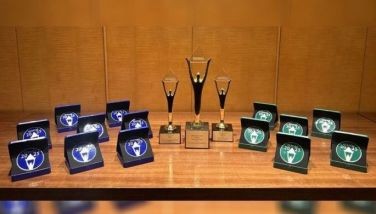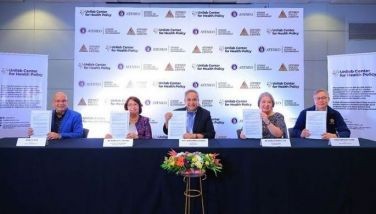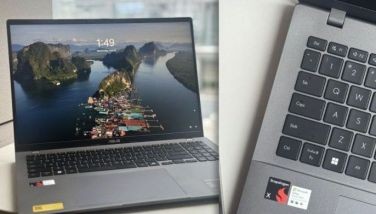US reneged before on Mutual Defense

America is fickle, while China will always be next door. That is the emerging Southeast Asian view of the two contending Pacific powers. China briskly has been trading with, investing in, and lending to the 10 ASEAN members. But it also has been raising the hackles of Vietnam, Indonesia, Malaysia, Brunei, and the Philippines with its unfounded nine-dash line claim to most of the South China Sea. That’s at the expense of their 200-mile exclusive economic zones under the United Nations Convention on the Law of the Sea. The United States on the other hand insists on all nations’ freedom of navigation in the open seas, but expects the five small ASEAN friends to do the enforcing for it. Only two weeks ago did it find the gumption to sail a missile cruiser to within 12 miles of one of eight reefs that China hurriedly has landfilled into artificial-island fortresses. Before that it was silent when China sent warships to escort a giant offshore oil rig off Vietnam’s coast. Silent too when a Chinese armada steamed through Brunei and Malaysian waters purportedly to patrol China’s southernmost sea borders. Most painfully for the Philippines, the US in 2012 reneged on its mutual defense commitment and let China grab Scarborough Shoal, a Filipino traditional fishing ground that the US itself had declared to be Philippine territory.
That Scarborough is part of the Philippines is etched in its shared history with America. Yet the US stayed neutral as China grabbed the shoal, by claiming that it does not interfere in other countries’ territorial disputes. In effect the US treated Scarborough as part of the Spratlys over which China and the Philippines are feuding, not a separate seamark that the US itself turned over to the Philippines. It fell for the Beijing propaganda that Scarborough is part of an imagined sub-archipelago of the Spratlys. That act makes hollow Barack Obama’s claim that America will come to the Philippines’ defense in case of invasion. One can’t take seriously the word of a shirker.
No less than the US Departments of State, Commerce, War, and the Navy previously had affirmed Philippine ownership of Scarborough. That was as far back as 1937, when then-Commonwealth President Manuel Quezon inquired with the US High Commission for the Philippines if his newly formed Coast Guard should patrol as well the horseshoe-shaped ring of rocks and reefs off western Luzon. Wayne Coy of the High Commission referred the matter on Dec. 6, 1937, to Capt. Thomas Maher, head of the US Coast and Geodetic Survey. Specifically, Coy wanted information if the shoal was being claimed by any country, particularly Britain whose Admiralty had charted the waters. Maher replied on Dec. 10 that there was no known claimant. His agency had no power to decide a sovereignty issue, Maher said, but noted that Spanish and other records, particularly the survey of the vessel Santa Lucia in 1800, suggested previous Spanish sovereignty. Wrote Maher: “If this survey would confer title on Spain or be a recognition of sovereignty, or claim for same without protest, the reef would apparently be considered as part of Spanish territory the transfer of which would be governed by the treaty of November 7, 1900.”
Maher was referring to the Treaty of Washington, which amended the Treaty of Paris of December 10, 1898. Signed “to remove any ground of misunderstanding growing out of the interpretation of Article III of the Treaty of Paris,” the second pact covered the outlying islands of the Philippines. Those islands were reported to mean Scarborough Shoal and parts of the Turtle Islands.
The US subsequently turned over the ceded Spanish territory to the Philippine Commonwealth. Coy relayed the information to Quezon, along with Maher’s recommendation to conduct a new survey of Scarborough and to install navigational lights. The issue did not end there, according to extensive researches by Dr. Jay Batongbacal, director of the University of the Philippines Institute for Maritime Affairs and Law of the Sea.
Months after the Coy-Maher exchange, Presidential Executive Secretary Jorge B. Vargas followed up the matter cautiously with Coy. Wrote he: “The Commonwealth Government may desire to claim title thereto should there be no objection on the part of the United States Government to such action.”
Coy forwarded the letter to the US Department of War, which in turn relayed it to the Department of State. “Very revealing,” Batongbacal now says of the resulting exchanges. On July 27, 1938, Secretary of State Cordell Hull informed Secretary of War Harry Woodring that: “This Department has no information in regard to the ownership of the shoal other than that which appears in the file attached to the letter under reference. While the shoal appears outside the limits of the Philippine archipelago as described in Article III of the American-Spanish Treaty of Paris of December 10, 1898, it would seem that, in the absence of a valid claim by any other government, the shoal should be regarded as included among the islands ceded to the United States by the American-Spanish treaty of November 7, 1900.”
Hull went on: “Accordingly, in the absence of evidence of a superior claim to Scarborough Shoal by any other government, the Department of State would interpose no objection to the proposal of the Commonwealth Government to study the possibility of the shoal as an aid to air and ocean navigation, provided that the Navy Department and the Department of Commerce, which are interested in air and ocean navigation in the Far East, are informed and have expressed no objection to the course of action contemplated by the Commonwealth Government.”
Soon afterwards Acting Secretary of the Navy W.R. Furlong wrote Acting Secretary of War Louis Johnson: “It is noted that the Commonwealth Government of the Philippine Islands desires to study the possibilities of this reef, particularly as to its value as an aid to air navigation and with the possibility of later claiming title thereto should there be no objection on the part of the United States Government to the such action.... The papers accompanying your letter, which are returned herewith, have been carefully considered and this Department has no objection to the course of action contemplated by the Commonwealth Government.”
On Oct. 19, 1938, Secretary of Commerce Paul Frizzell wrote the Secretary of War: “It is noted that the Commonwealth Government of the Philippines desires to study the value of Scarborough Shoal as an aid to air navigation with the possibility of later claiming title thereto. It is further noted that the Secretary of State will interpose no objection to the proposal of the Commonwealth Government, provided the Navy and Commerce departments express no objection. “Please be advised that the Civil Aeronautics Authority sees no objection to the proposed action.”
Those correspondences affirmed the Commonwealth Government’s jurisdiction over Scarborough. Consequently the Philippines installed navigational markers, included the shoal in all the country’s maps, and conducted with the US maritime safety and rescue exercises. All this is recorded in the Coast Pilot Guides issued by the US Coast and Geodetic Survey, and in search-and-rescues on the shoal.
Before the Commonwealth Period, however, America exercised control over Scarborough. Spain had ceded the shoal to it as Bajo de Masinloc, or lower Masinloc, the town of Zambales province 123 kilometers in the mainland. Before that it was referred to in Spanish maps of the Philippines as Punto de Mandato, or Point of Mandate, meaning an official outpost. Maps drawn by British and Japanese navigators considered the shoal as part of the Philippine colony. Those were considered in the two Spanish-American treaties that presaged the American Colonial Period in the Philippines, 1899-1935.
One of the first acts of the Colonial Government concerning Scarborough was to resurvey the shoal and pinpoint its exact location. Before then, there were thought to be two adjacent shoals, one big and the other half its size. The US Coast and Geodetic Survey plotted the longitude and latitude.
In 1913 occurred a shipwreck in the shoal of the Swedish steamer S.S. Nippon. Rescuers rushed in from Luzon, later followed by salvors of the cargo. Disputes erupted about the payments of the salvors and by the insurers. A Philippine court handled the legal cases that reached all the way to the Philippine Supreme Court in 1916.
Although the Philippine Supreme Court at the time was under a Filipino Chief Justice (in 1916 Cayetano Arellano), at least five of the nine justices were Americans. Moreover, its decisions were appealable to the US Supreme Court. The US thus had legal jurisdiction over the cases arising from the shipwreck in Scarborough, as part of the Philippine colonial territory.
The Bureau of Navigation of the Colonial Government closed the case by conducting studies on how long certain products, like copra, would last under seawater.
The Colonial Government in 1918 inventoried the islands of the Philippines for publication in a census. Scarborough Shoal is included.
After World War II the US expanded its Clark and Subic military bases in Pampanga and Zambales. Jointly with Philippine forces, it used Scarborough for warplane bombing runs and warship shelling practice. On all such exercises the US would ask the Philippines to issue Notices to Mariners to steer clear of the shoal for their own safety. Such issuances are US acknowledgements of Scarborough as Philippine-owned.
All these are proofs of US affirmation of Scarborough as Philippine territory -- to be defended like any other part against any invader, under the RP-US Mutual Defense Treaty. Yet it did not lift a finger as China grabbed the shoal. Now it wants the Philippines, with its puny Armed Forces, to defend America’s freedom of navigation in the South China Sea.
The US would not have had to go to war with China had it taken the Philippine side in 2012, surmises Supreme Court Senior Justice Antonio Carpio, who helped file the consequent arbitration with the UN. China is in no position to start a shooting war. “Had the US been steadfast in its treaty commitment, Scarborough would still be ours,” Carpio sighs.
* * *
Catch Sapol radio show, Saturdays, 8-10 a.m., DWIZ, (882-AM).
Gotcha archives on Facebook: https://www.facebook.com/pages/Jarius-Bondoc/1376602159218459, or The STAR website http://www.philstar.com/author/Jarius%20Bondoc/GOTCHA
- Latest
- Trending
























